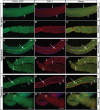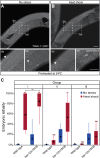The Stress Granule RNA-Binding Protein TIAR-1 Protects Female Germ Cells from Heat Shock in Caenorhabditis elegans
- PMID: 26865701
- PMCID: PMC4825639
- DOI: 10.1534/g3.115.026815
The Stress Granule RNA-Binding Protein TIAR-1 Protects Female Germ Cells from Heat Shock in Caenorhabditis elegans
Abstract
In response to stressful conditions, eukaryotic cells launch an arsenal of regulatory programs to protect the proteome. One major protective response involves the arrest of protein translation and the formation of stress granules, cytoplasmic ribonucleoprotein complexes containing the conserved RNA-binding proteins TIA-1 and TIAR. The stress granule response is thought to preserve mRNA for translation when conditions improve. For cells of the germline-the immortal cell lineage required for sexual reproduction-protection from stress is critically important for perpetuation of the species, yet how stress granule regulatory mechanisms are deployed in animal reproduction is incompletely understood. Here, we show that the stress granule protein TIAR-1 protects the Caenorhabditis elegans germline from the adverse effects of heat shock. Animals containing strong loss-of-function mutations in tiar-1 exhibit significantly reduced fertility compared to the wild type following heat shock. Analysis of a heat-shock protein promoter indicates that tiar-1 mutants display an impaired heat-shock response. We observed that TIAR-1 was associated with granules in the gonad core and oocytes during several stressful conditions. Both gonad core and oocyte granules are dynamic structures that depend on translation; protein synthesis inhibitors altered their formation. Nonetheless, tiar-1 was required for the formation of gonad core granules only. Interestingly, the gonad core granules did not seem to be needed for the germ cells to develop viable embryos after heat shock. This suggests that TIAR-1 is able to protect the germline from heat stress independently of these structures.
Keywords: C. elegans; TIA-1/TIAR; germ cells; stress; stress granules.
Copyright © 2016 Huelgas-Morales et al.
Figures










Similar articles
-
The C. elegans TIA-1/TIAR homolog TIAR-1 is required to induce germ cell apoptosis.Genesis. 2013 Oct;51(10):690-707. doi: 10.1002/dvg.22418. Epub 2013 Aug 30. Genesis. 2013. PMID: 23913578
-
GLS-1, a novel P granule component, modulates a network of conserved RNA regulators to influence germ cell fate decisions.PLoS Genet. 2009 May;5(5):e1000494. doi: 10.1371/journal.pgen.1000494. Epub 2009 May 22. PLoS Genet. 2009. PMID: 19461891 Free PMC article.
-
The stress granule component TIA-1 binds tick-borne encephalitis virus RNA and is recruited to perinuclear sites of viral replication to inhibit viral translation.J Virol. 2014 Jun;88(12):6611-22. doi: 10.1128/JVI.03736-13. Epub 2014 Apr 2. J Virol. 2014. PMID: 24696465 Free PMC article.
-
Germ granules and gene regulation in the Caenorhabditis elegans germline.Genetics. 2022 Mar 3;220(3):iyab195. doi: 10.1093/genetics/iyab195. Genetics. 2022. PMID: 35239965 Free PMC article. Review.
-
Connecting the Dots: Linking Caenorhabditis elegans Small RNA Pathways and Germ Granules.Trends Cell Biol. 2021 May;31(5):387-401. doi: 10.1016/j.tcb.2020.12.012. Epub 2021 Jan 29. Trends Cell Biol. 2021. PMID: 33526340 Review.
Cited by
-
Two predicted α-helices within the prion-like domain of TIAR-1 play a crucial role in its association with stress granules in Caenorhabditis elegans.Front Cell Dev Biol. 2023 Dec 15;11:1265104. doi: 10.3389/fcell.2023.1265104. eCollection 2023. Front Cell Dev Biol. 2023. PMID: 38161334 Free PMC article.
-
Efficient Transgenesis in Caenorhabditis elegans Using Flp Recombinase-Mediated Cassette Exchange.Genetics. 2020 Aug;215(4):903-921. doi: 10.1534/genetics.120.303388. Epub 2020 Jun 8. Genetics. 2020. PMID: 32513816 Free PMC article.
-
C. elegans SUP-46, an HNRNPM family RNA-binding protein that prevents paternally-mediated epigenetic sterility.BMC Biol. 2017 Jul 17;15(1):61. doi: 10.1186/s12915-017-0398-y. BMC Biol. 2017. PMID: 28716093 Free PMC article.
-
The mTOR-S6 kinase pathway promotes stress granule assembly.Cell Death Differ. 2018 Nov;25(10):1766-1780. doi: 10.1038/s41418-018-0076-9. Epub 2018 Mar 9. Cell Death Differ. 2018. PMID: 29523872 Free PMC article.
-
T-Cell Intracellular Antigen 1-Like Protein in Physiology and Pathology.Int J Mol Sci. 2022 Jul 16;23(14):7836. doi: 10.3390/ijms23147836. Int J Mol Sci. 2022. PMID: 35887183 Free PMC article. Review.
References
Publication types
MeSH terms
Substances
Grants and funding
LinkOut - more resources
Full Text Sources
Other Literature Sources
Research Materials
Miscellaneous
